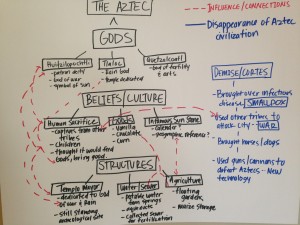I chose to do my concept map on the Aztec culture/civilization because I am very interested in how they lived and what they believed in. I organized it based on what I found interesting and how those subjects related to each other. I chose to draw it out on a large piece of paper because I am a visual person and I don’t prefer to use technology.
As you can see I used red to connect themes and subjects that influence each other. For instance the Aztec’s believed in Gods so they built structures (temples) to honor them and then sacrificed humans at those structures to please their Gods. They might have believed that by sacrificing humans it would bring light, rain and fertility to their people. I was also interested that the Aztec’s were a “clean” civilization. They got their water from clean springs and disposed of their sewage in a modern way. They also reused their sewage as fertilizer for the floating gardens. Last but not least I was fascinated by how people think that the Aztec’s “disappeared”. But really their civilization was confronted by a Spanish Conquistador Cortes, who wanted to conquer their city. He found that surrounding tribes were enemies to the Aztecs and used them to wage war. Many Aztec’s perished because unknowingly the Spanish fleet brought over a deadly disease, smallpox. It wiped out at least half of the population because they had never been exposed to the disease, and therefore did not have immunity to it.
